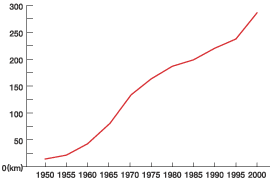|
The first subway line in Japan, indeed the first in Asia, opened 75 years ago in December 1927. It was a short line, covering only 2.2 km from Asakusa to Ueno in Tokyo. Today, Tokyo has 13 subway lines, with a total length of 286.2 km in operation, making it the third-largest subway network in the world.
Nine of the thirteen lines are operated by the Teito Rapid Transit Authority (Eidan). Eidan is a special corporation established by the national and Tokyo metropolitan governments. The other four lines are operated by the Tokyo Metropolitan Government (Toei). In Tokyo's 23 cities there are 224 stations—an average of one station per 1.66 square kilometers in the 23-city region. Of course, in the inner-city areas some subway lines converge and cross each other, bringing stations even closer together there.
With so many subway lines, you can generally get quite close to where you want to go. You can transfer from one subway line to another, and from subway lines to suburban railways operated by private companies or East Japan Railway Company (JR). This has made commuting convenient, except that the network configuration and passageways between lines are often quite convoluted. For example, Nagatacho Station (Yurakucho line) and Akasaka Mitsuke Station (Marunouchi line) are only 250 meters apart, measured in a straight line, but if you transfer from one station to the other you'll have to walk 500 meters and traverse the platform of another station called Nagatacho, on the Hanzomon line.
A number of books have been published to give hints on transferring from one line to another within this convenient yet complicated subway network.
To travel on different lines you don't always have to transfer, since many subway trains and suburban trains operated by different companies offer through services on each other's lines. For example, the Hanzomon subway line links up with the Tokyu Den-en Toshi line at Shibuya, the Chiyoda subway line with the JR Joban line at Ayase, and the Toei Mita and Nanboku subway lines with the Tokyu Meguro line at Meguro. Through services linking subway lines with private or JR railway lines save many commuters the trouble of changing trains.
Subway users in the vast metropolis of Tokyo are calling for even more convenience, and this has led to the planning of new lines and extensions. The eastern end of the Hanzomon line will gain four new stations in 2003, and a new subway line between Shibuya and Ikebukuro is planned for 2007. Tokyo's subway network, like the subterranean arteries of the metropolis, continues to evolve.  |
|
Major subway networks of the world:
Length of track in operation, and annual ridership
|
London
(U.K.)
|
|
 |
|
New York
(U.S.A.)
|
 |
|
Tokyo
(Japan)
|
 |
|
Moscow
(Russia)
|
 |
|
Paris
(France)
|
 |
|
|
 |
Length of track in operation
|
 |
Annual ridership
|
Tokyo subway network: Length of track in operation, 1950-2000

Breakdown for most recent year: Eidan lines, 177.2 km; Toei lines, 109.0 km
Line with greatest frequency at peak hours, and scheduled interval between trains
Marunouchi line, 1 min. 50 sec. to 3 min. (branch line, 4 min. 20 sec.)
Line with greatest trains
Tozai line, 100 km/hr (express trains)
Busiest stations, and number of daily users
|
Busiest:
|
Ikebukuro (Marunouchi and Yurakucho subway lines)
|
485,133
|
|
|
2nd busiest:
|
Kita-senju (Chiyoda subway line)
|
351, 230
|
|
|
3rd busiest:
|
Otemachi (Marunouchi, Tozai, Chiyoda and Hanzomon lines)
|
287,714
|
|
|
* Daily average, fiscal 2000 (results of Eidan survey)
|
Number of employees
Eidan: 9,696
Toei: 3,895
Number of stations
Eidan: 134
Toei: 98
Underground station closest to the surface, and distance from track to ground level
Minami-sunamachi Station, Tozai line, 6.2 m
Underground station deepest underground, and distance from track to ground level
Roppongi Station, Oedo line, 42.3 m
|